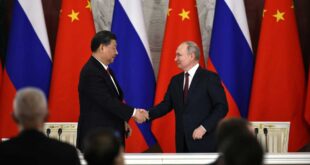Paul Heer
Will Beijing and Washington work things out?
It is too soon to tell what net impact the COVID-19 pandemic crisis will have on the U.S.-China relationship. Several indicators point toward an accelerated deterioration as the two sides point fingers of blame at each other and compete for credibility and influence amidst the global response. But the crisis is also highlighting the opportunity—and the need—for Beijing and Washington to join forces against the virus, and thus open a path toward greater bilateral cooperation and the building of mutual trust.
Recall the trajectory that U.S.-China relations were on when 2020 began, just as COVID-19 was escaping from Wuhan. Washington and Beijing were in a downward spiral, fueled by several geopolitical trends. First was the growing divergence between the perceived “rise of China” and relative decline of the United States—especially since the global financial crisis of 2008-9. This prompted Beijing to press its material advantages in an effort to expand its global influence, while Washington started grappling simultaneously with domestic dysfunctionality and the emerging limits on its international clout. Second was the presumption—largely due to the baggage of the Cold War—that this divergence reflected and reinforced an existential ideological contest between the two sides. Third was the escalation of bilateral tensions over the past three years, fueled by the trade war and growing U.S. attention to expansive Chinese economic diplomacy, military deployments, and influence operations.
A fourth factor, flowing from the first three, has been the tendency of both Beijing and Washington to willfully misinterpret and misrepresent each other’s strategic intentions. Beijing sees evidence of a U.S. strategy of containment and regime change everywhere. Washington similarly views Chinese actions as revealing a pursuit of global hegemony, and equates all of China’s competitive international behavior with that subset of it which is predatory or malign or “against the rules.” All this was making it harder for each side to genuinely understand the other’s perspective or acknowledge any validity to it. It was also making it easier for each side to blame the other for self-inflicted problems.
Enter COVID-19. The early responses by both Beijing and Washington have predictably reflected these preexisting trends, in terms of strategic mistrust, misunderstanding, and rivalry—increasingly colored by mutual hostility and blame. This has been most apparent in two areas: competing claims about the origins of the virus, and competing narratives about which country is contributing more effectively to combating it.
The competing conspiracy theories about the source of COVID-19 were most notably circulated by a Chinese diplomat who floated the idea that the virus may have been introduced into Wuhan in October 2019 by U.S. military personnel (who were there to participate in the Military World Games); and a U.S. senator who (among others) floated the theory that the virus originated in a bioweapons laboratory in Wuhan. There is, of course, an important difference between a Chinese diplomat who was seemingly speaking authoritatively for Beijing, and a senator who in the U.S. system represents only his own views. In any event, both sides have rhetorically retreated somewhat from these allegations. But they nonetheless revealed a latent bilateral hostility and distrust, and a readiness to blame the other side for the impact of the virus.
The truth is that both sides badly mishandled the early stages of the virus’s spread—due to lack of preparedness, genuine uncertainty and confusion about what was happening, avoidance of responsibility for a daunting crisis, and reluctance to impose the draconian measures it would require. The issue became politicized on both sides, albeit in very different ways: the Chinese Communist Party skirted transparency and honesty in the early stages of the outbreak in an attempt to forestall public criticism of its competence; and the Trump Administration delayed acknowledging the seriousness of COVID-19 on the grounds that it was being exaggerated by his political rivals in an attempt to erode his reelection prospects. This will come back to haunt both governments.
All the evidence—albeit with some loose ends—points to the virus originating in Wuhan, and important questions remain to be addressed about Beijing’s systemic lapses and delays in identifying it, limiting its spread, and notifying other countries. But in many respects, what happened in December and January is water under the bridge. The United States is now in the throes of a crisis the severity of which is almost certainly more attributable to its own lack of preparedness—despite advance notice that Beijing didn’t have—than to Beijing’s early failure to contain the virus.
The second set of competing narratives involves the two sides’ characterization of each other’s diplomatic response to the global spread of COVID-19. Predictably, and accurately, much U.S. commentary is highlighting Beijing’s efforts to portray its apparent success in reining in the spread of the virus inside China as an example for the rest of the world to follow—and thus as an illustration of the superiority of China’s development and governance model. This echoes the pre-COVID U.S. portrayal of Chinese foreign policy as aimed at exporting its model as part of a strategy to discredit the U.S. system and ultimately supplant U.S. global leadership. Accordingly, Washington has accelerated its own public diplomacy campaign to discredit Beijing’s model, highlight its culpability in the spread of the virus, and compete for the hearts and minds of other countries needing aid to deal with the crisis.
Yes, Beijing obviously is taking advantage of this opportunity to score points in its strategic competition with the United States, and to advance its pursuit of the “reform of global governance” and an international “community of common interest” that is more attentive to and representative of China’s interests. And Beijing clearly is seeking to deflect attention from its mishandling of the initial outbreak and instead highlight problems with the U.S. response to the virus. China is also accelerating and expanding its delivery of medical supplies and expertise to countries in need. As a result, it is altogether possible that, when the crisis has passed, Beijing will have a more positive international reputation than it did before the pandemic, even if that reputation still falls short of Washington’s.
But it remains important in the wake of COVID-19, as it was before the virus, not to overstate or otherwise misrepresent Beijing’s strategic ambitions in this regard. Although China is seeking to extend its international influence relative to—and even at the expense of—that of the United States, it is not seeking to vanquish the United States or to supplant it as the global hegemon. China’s objectives are more limited and pragmatic than that, because its leaders recognize that global hegemony, even if it were achievable—which they appropriately doubt—would be unsustainable and more of a burden than a boon. Instead, Beijing is seeking to legitimize its model of governance and development internationally so that it can peacefully coexist with other models and increase China’s weight in setting the rules of global governance. Moreover, Beijing wants to validate the Chinese Communist Party’s domestic rule and secure a peaceful external environment that allows Beijing to confront its myriad and daunting internal priorities. COVID-19 has given Beijing an opportunity to advance all these goals, by asserting that its system has been effective in reining in the virus at home and offering assistance and advice abroad.
This is more than sufficient to constitute an unprecedented strategic challenge to the United States—without requiring the belief that China is trying to undermine America in a bid to rule the world. It nonetheless reflects the prevailing strategic competition between the U.S. and Chinese systems. In response, the United States needs to do what was already clear before COVID-19: get back on the international playing field and start scoring points for its own model of governance and development. Unfortunately, the impact of the virus itself is now making that substantially more difficult. China has a head start because, by all indications, it is already on the down side of the worst impact of the virus—pending another possible wave of infections—and it is a repository for the kind of medical equipment and expertise that the world is now desperately seeking. For its part, the United States has been crippled by COVID-19 and is still approaching the peak of its devastating impact. Some of the vulnerabilities of its system are precisely what is hampering the U.S. response to the virus. And the United States is now one among the many countries that need assistance from China.
Americans are reacting instinctually to these circumstances by criticizing Beijing’s opportunism and ambulance-chasing, and taking steps to counter China’s narrative and boost Washington’s own contributions to the international response to COVID-19. On the positive side, this can and should involve mobilizing Americans’ competitive and humanitarian instincts as the country rises to the simultaneous challenges of the virus itself and of Beijing’s efforts to parlay it into geopolitical advantage. On the other hand, some U.S. responses are likely to be counterproductive—such as escalating the blame game by demanding that Beijing be required to pay reparations for causing the virus; and citing the virus as another reason to decouple the American and Chinese economies (especially to eliminate any U.S. reliance on Chinese medical exports). Such proposals will remain fruitless or otherwise problematic.
 Geostrategic Media Political Commentary, Analysis, Security, Defense
Geostrategic Media Political Commentary, Analysis, Security, Defense





